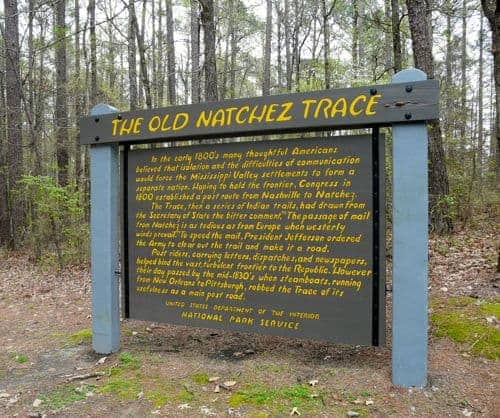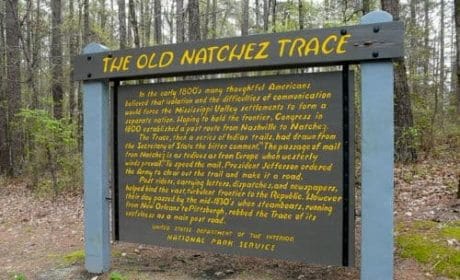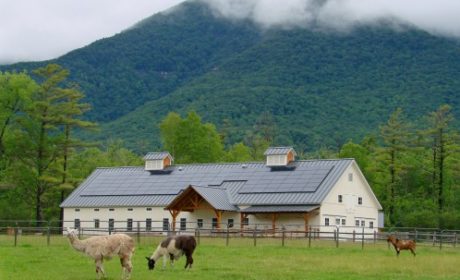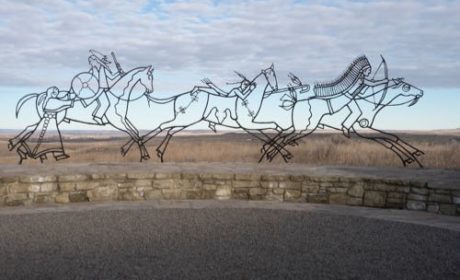On a Natchez Trace road trip, you’ll experience history, culture and a scenic drive through beautiful areas of the South. Alan and I have driven a small portion of the road on a short, Natchez Trace tour.
However My Itchy Travel Feet Featured Contributor, Debi Lander from ByLanderSea, drove the entire parkway. She shares her Natchez Trace itinerary so that you can do that, too!
The 444-mile Natchez Trace Parkway runs from Nashville, Tennessee, to Natchez, Mississippi. The recreational road and scenic drive links the Cumberland, Tennessee, and Mississippi rivers, while passing through three states.

Table of Contents
What is the Natchez Trace Parkway?

The Natchez Trace Parkway roughly follows the “Old Natchez Trace.” The historic travel corridor was used by American Indians, “Kaintucks,” European settlers, slave traders, soldiers, and future presidents.
The National Park Service manages the Parkway (official website), so I think of it as a very long, but narrow National Park travel adventure. The landscape includes trails, campgrounds, historic markers, and bodies of water.

On a Natchez Trace road trip, you’ll find the two-lane parkway permits no billboards, trucks, hotels or gas stations—and limits speed to 50 mph. It’s like taking a Sunday drive on a rural country road.
My girlfriend Judy and I carefully planned a slow, southern sojourn centered around the Trace. We would drive the route, stopping to explore and stay in nearby cities.
We hoped to discover American history, country music, and indulge in southern cuisine. While others enjoy hiking, biking, horseback riding, and camping on the Trace, we chose less adventurous, but more comfortable activities.
The History of the Natchez Trace Trail

The original trail comprised a patchwork of foot trails stretching over Choctaw and Chickasaw land. The early travelers encountered many hardships among the swamps, dense forest, and rivers.
Over time, some of the footpaths were beaten down, creating long passages with banks so high travelers could only see what lay immediately ahead. Lying in wait were bands of robbers anxious to steal from the traders heading home.
It took about 35 days to traverse the Natchez Trace trail by foot, 25 days on horseback. Life was tough, but the settlers, soldiers and opportunists were tougher.
Passing along the original Natchez Trace were figures from history such as Daniel Boone, Aaron Burr, Washington Irving, the great chief Tecumseh, David Crockett, Jim Bowie and Andrew Jackson. Even Meriwether Lewis of Lewis and Clark trekked this route, although he died under mysterious circumstances at Grinder’s stand and is buried nearby.
By 1809, the Trace had been widened to accommodate wagons, making it an important trade route between Nashville and the Mississippi River. It continued to flourish until the rise of the steamboat, then slowly fell into disuse.
By the Civil War, the Natchez Trace was all but forgotten though some skirmishes and battles were fought in the vicinity.
The trail would likely be lost had it not been for the formidable ladies of the DAR (Daughters of the American Revolution). They brought the project to the attention of lawmakers and raised funds.
The National Park Service took over in 1938. The Parkway was finally completed in 2005.
Boomer Travel Tip
Use our road trip planner to make the most of your next road trip adventure.
Start your Natchez Trace Road Trip in Nashville

Judy and I flew to Nashville to soak in the lively atmosphere of Music City and take in a performance at the Grand Ole Opry. The next morning, we entered the beginning (or end) of the well-marked Trace at the Double Arch Bridge.
As bridges go, the Double Arch is a lovely thing, impressive in its simplicity. However, getting our first glimpse of the scenic Parkway, made us feel conflicted. We wanted to continue down the canopy-covered road, but our plans included a longed-for visit to Graceland in Memphis. Elvis was calling.
We detoured to Memphis and found those ghosts of Elvis—lurking among his home, costumes and platinum records. The King still reigns supreme at Graceland.
Diverting to Tupelo

Tupelo, Mississippi lies two hours south of Memphis; its claim to fame is the Elvis Presley Birthplace Park. The 15-acre setting features the wooden, two-room shotgun house where the performer was born.
The house is so small that it only takes about five minutes to tour. His family moved around, losing the home, but remaining in this neighborhood, until moving to Memphis.
Of course, the Birthplace Museum showcases Elvis’ early years. The Presley childhood church was moved to the site and you can stop in a memorial chapel next door, built after his death.

Two statues grace the hill above. The pair, entitled Becoming, symbolize the transformation of Elvis, The Boy at 11, to Elvis, The Entertainer. Well done!
Downtown Tupelo tributes include several colorful murals, street-side, and guitar-shaped artworks. Of course we visited Tupelo Hardware, the place Elvis’ Mama bought him his first guitar.
Judy and I spent the night in Tupelo (search for hotels here) after dining at the Blue Canoe (renowned for its live music and Blueberry Donut Bread Pudding). A suggested Elvis-themed breakfast made me hesitant, but the King Chicken Fillin’ Station’s proved over the top delicious—as were the calories.
Natchez Trace Parkway Headquarters

Before driving the trace, we stopped at the Natchez Trace Visitor Center in Tupelo to see the introductory film. As always, the National Park Service does a good job with their presentations; this one explores the trail’s history. Highly recommended.
The official Natchez Trace map (available at the center or online) denotes the numerous historical markers, all designed to pull off and park. We used the map as our Natchez Trace trip planner, stopping frequently and occasionally finding something interesting enough to get us out of the car.

For example, at the Chickasaw Village site, homeland to the tribe, we looked at artist renderings and walked a short interpretive trail. Plans to reconstruct a fort and village have not reached fruition. The tribe was one of many forced to relocate to Oklahoma in the 1800s.
At another marker, we walked five minutes to reach old Confederate graves with stone markers. A group of motorcyclists were putting flags on the gravesites.
Boomer Travel Tip
Need to update your road trip gear? Start with our recommendations for best road trip gear.
Stopping in Jackson, Mississippi
Jackson lies just 10 miles off the Trace, an ideal place to spend a night. After all, it’s the state capital and boasts two fantastic museums: the Mississippi History Museum and the Mississippi Civil Rights Museum.
Good thing we allotted the entire afternoon. The two attractions jointly cover 200,000 square feet and include 22,000 artifacts. As recommended, we started on the history side and found the 1800-1900s the most interesting.
The Civil Rights Museum

The state-of-the-art Mississippi Civil Rights Museum presents powerful stories. You’ll find eight interactive galleries with striking images and displays. Seven of the galleries encircle a central space, highlighted by a sculpture called “This Little Light of Mine.”
You move from the darkened galleries into the light as you work your way around the museum. The sculpture becomes brightest when the music of the Movement swells, about every 15 minutes.
I found myself pulled in by the clapping, swaying and singing. This spot is truly uplifting, a good thing because there’s no sugarcoating here. The museum tells poignant, often tearful tales.
A lynching tree inscribed with names bears witness to the 600 Mississippians hung in the state. Other displays include Ku Klux Klan robes, the rifle that killed Medgar Evers, plus many informative videos set within small spaces—for example, the back of a police wagon or a jail cell.
The Mississippi Civil Rights Museum highlights stories that Americans can’t and shouldn’t forget. It’s a must-visit while visiting the state.
Dining in Jackson, Mississippi

For dinner, we headed to Babalu, a restaurant named after the signature song of the television character Ricky Ricardo, played by Desi Arnez, on I Love Lucy. The Latin-inspired menu features tapas and tacos instead of typical southern fare. Try their signature fresh guacamole made tableside along with the house margarita: The Baba Rita.

For breakfast, boomers will love Brent’s Drugs, an old-fashion pharmacy/soda fountain that takes you back to childhood days. The place opened in 1946 and feels like a time capsule with real soda jerks.
No surprise, many scenes in the movie The Help (did you read the book?) were filmed there. Hidden in the rear of Brent’s you’ll discover The Apothecary—the most wonderful speakeasy-style bar. I wish we’d known of this earlier.
The Mississippi State Capitol
In my opinion, state capitols are always worth a visit. They burst with grandeur and symbolic art.
Judy and I quickly popped in to the Mississippi State Capitol building for a self- tour using the visitor brochure as our guide. We loved the rotunda and thought it fun to see author John Grisham’s photo on the wall (1983-90) when he was representative of the State Senate.
Touring Vicksburg

Vicksburg also lies about 25-30 off the Trace but should be included on the road trip. The Vicksburg National Military Park (official website), a unit in the National Park Service, is the most visited site in the entire state.
Hire a guide (at the visitor center) to join you in your car. Ours was a walking encyclopedia with knowledge about the battles, the importance of topography, and what happened to those in the town.

Stop for lunch at Walnut Hills Restaurant for a fabulous family-style meal. The table will be laden with bowl after bowl of Southern specialties: green beans, turnip greens, macaroni & cheese, coleslaw, creamed corn, cheese broccoli, fried okra, cheese grits, black-eyed peas, rice and gravy, plus a basket of cornbread and biscuits.
Then, comes the fried chicken, honestly the best I have ever tasted anywhere—almost enough to make you drool.

The Cedar Grove Mansion Inn, a bed & breakfast surrounded by manicured gardens, immediately put us under its spell. We indulged in the gracious charm of the Antebellum estate, honestly an attraction on its own.
Judy slept in the General Grant room, including many original furnishings. I enjoyed the General Sherman room.
Windsor Ruins
Vicksburg could have kept us busy another day and night, especially if we’d been interested in gambling. Casinos do big business in Vicksburg.

Instead, we headed toward the Windsor Ruins near Port Gibson, getting a bit lost in kudzu covered territory. The ruins are all that remain of what was once a palatial mansion, but they make a haunting sight and favorite of photographers.
Onward to Natchez

Driving again on the well-marked Natchez Trace felt like a breath of fresh air. The Parkway eliminates stress unless you can’t abide the 35mph speed limit. On the Trace, you’re surrounded by nature and feel the joy of being behind the wheel.
Reaching the city of Natchez, however, wasn’t the end of the trip. We stayed two more days and basked in elegance and charm.

In Natchez, history runs deep and we specifically timed our trip to coincide with the Fall Pilgrimage of Homes, a semi-annual event when rich antebellum splendor shines. Historic homes, including some privately-owned homes, open for special tours. Costumed, knowledgeable guides share the history of the houses, families and city.
We started at Green Leaves where the owner was our guide, a descendant of the original owner. An incredible variety of priceless keepsakes fill this home.
On the back porch, we found period costumes and were encouraged to try them on. Judy and I didn’t hesitate. We delighted in the opportunity and almost felt like real Southern belles.

Touring Longwood, the grand dame of Natchez, should be on everyone’s list. The massive, but unfinished octagonal house shows its designed-to-impress wealth on the outside. Only the lower floor was ever completed but it contains many original pieces and paintings.
Greek Revival Stanton Hall, built in the 1850s by a cotton merchant, remains one of the most opulent antebellum mansions to survive the Civil War. Thankfully, many Natchez homes were spared and therefore include fine antiques.
Many refer to Rosalie Mansion, built with red bricks in 1823, as Our Lady of the Bluffs. The house overlooks the river on the site of Fort Rosalie. During the Civil War, the home and grounds acted as the Union Army headquarters for the Natchez area, but the owner’s wife and daughter remained in residence.

Judy and I stayed at the Monmouth Historic Inn, a gorgeous property with 26-acres of bucolic grounds. Overnight guests feel the colonial ambiance of the mansion, yet stay in period-looking cottages with all the modern amenities.
Their famed bartender will mix up the ‘best mint julep in the South’ to guarantee good moods. Even if you don’t stay there, drop by for a cocktail. Better yet, stay for dinner at Restaurant 1818; we feasted on a grand meal featuring decadent seafood.
There’s more to Natchez than wealth. You can’t leave the Mississippi city until you’ve gone down by the river’s edge. Stop at Natchez Under-the-Hill, a row of riverfront restaurants and shops far tamer than the brothels, taverns and gambling halls that stood there 200 years ago.
Locals and tourists alike sip drinks at the popular Under-the-Hill Saloon. This area radiates a fun, lively atmosphere and becomes especially popular at sunset.
Finally, it was time to return the rental car in New Orleans and fly back to Florida. Our Natchez Trace trip and exploration of cities in Mississippi far exceeded our expectations.
We learned fascinating tales of American history and savored much Southern cuisine. Road trips that get off the highways are the best way to see the USA and the Trace certainly offers a traveler many options.
Frequently Asked Questions about driving the Natchez Trace
The parkway stretches 444 miles through Tennessee, Alabama and Mississippi.
The Trace has been a unit of the National Park System since 1938.
The Parkway can be driven in two days, but why hurry? Take your time by stopping at all of the pullouts, taking short hikes and exploring nearby communities.
Nashville, Tennessee and Natchez, Mississippi are the end points of the Natchez Trace. Those traveling south will begin in Nashville and end in Natchez. For drivers motoring north, the road begins in Natchez and travels north to Nashville.
The road is mostly posted at 50 mph, however some sections have a lower speed limit. This is a road for taking it slow and enjoying your surroundings so don’t hurry the trip.
You won’t find any lodging on the Natchez Trace Parkway itself, except for three primitive campgrounds. However you’ll find bed and breakfasts, inns and hotels in nearby communities. Take the opportunity to explore while you’re there.
Active travelers will enjoy biking on the Parkway. Horseback riding, fishing and hiking are other options. Hiking trails vary in length but include short paths that travel the original Trace.
In spring, you’ll enjoy flowering dogwoods and wildflowers. Fall offers a colorful scene from the changing leaves. Summer is hot and humid on the Parkway.
Many thanks to Mississippi Tourism, especially Visit Tupelo, Visit Jackson, Visit Natchez, and Visit Vicksburg for their support of our Natchez Trace road trip. For more information and tourist tips visit their websites.
Save to Pinterest






